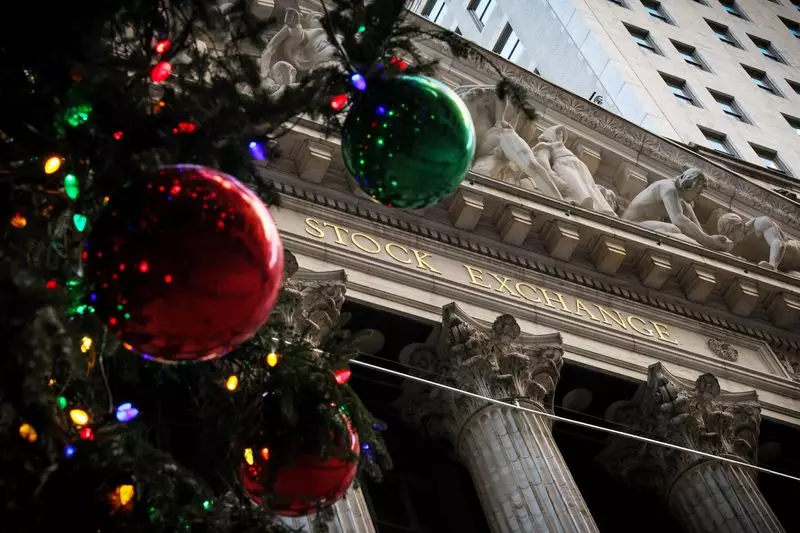U.S. stocks closed on a mixed note as investors prepared for the Christmas holiday weekend. The market reacted to cooler-than-expected inflation data, which increased the likelihood of Federal Reserve interest rate cuts in the coming year. While the Nasdaq and S&P 500 ended in positive territory, the blue-chip Dow finished slightly lower.
As the afternoon progressed, trading became less decisive and volumes decreased. This could be attributed to traders and investors being cautious before a long weekend and the presence of geopolitical risks. However, it’s important to note that the overall sentiment in the market remains positive, thanks to the significant rally experienced recently.
Small-cap stocks delivered an impressive performance, outperforming the broader market. The Russell 2000, which represents small-cap companies, ended the day with a gain of 0.8%. Additionally, all three major indexes recorded their eighth consecutive weekly gains, signifying a prolonged winning streak. The S&P 500 is now within 1% of reaching its all-time high, a clear indication that the market has been in a bull run since October 2022.
The fourth quarter of the year has been extraordinary in terms of market performance. The Russell 2000, which was initially down for the year as of August, has bounced back and achieved a remarkable gain of 15.6% for the year. This impressive turnaround demonstrates the significant growth potential of small-cap stocks and strengthens the argument that the current market rally is not limited to any particular sector but rather encompasses a wide range of industries.
Ahead of the long weekend, several important economic reports were released. The Commerce Department’s Personal Consumption Expenditures (PCE) report indicated that inflation continues to move closer to the Federal Reserve’s target of 2%. Simultaneously, a separate report showed that new orders for core capital goods exceeded analysts’ expectations, suggesting positive prospects for corporate spending in the United States. These releases further solidify the belief that the Federal Reserve may commence interest rate cuts as early as March 2024. Moreover, it reflects the possibility of the central bank successfully managing inflation without causing an economic downturn, thereby achieving a “soft landing.”
The dovish PCE report may prompt some analysts to call for interest rate cuts in March, but caution is warranted. There is a belief that the economy is currently performing strongly and does not require lower interest rates. Financial markets, however, have priced in a 74.1% likelihood of a 25 basis point rate cut by the Federal Reserve in March, according to CME’s FedWatch tool.
In terms of individual stock performance, the Dow Jones Industrial Average recorded a marginal decline of 0.05%. The S&P 500, on the other hand, experienced a modest 0.17% gain, and the Nasdaq Composite ended the day with a 0.19% increase. Among the 11 major sectors in the S&P 500, consumer discretionary was the only sector that experienced a decline, while consumer staples saw the largest percentage gain.
Nike, the sportswear maker, faced a significant setback with an 11.8% drop in its stock price. This decline came after the company lowered its annual sales forecast due to cautious consumer spending. Other companies in the industry, such as Foot Locker and Dick’s Sporting Goods, also experienced losses of 2.7% and 3.9%, respectively.
In contrast, Karuna Therapeutics witnessed a remarkable 47.7% increase in its stock price. The surge followed Bristol Myers Squib’s agreement to acquire the drugmaker for $14 billion in cash. This acquisition news propelled Karuna Therapeutics to new highs and reflected positive sentiment in the healthcare sector.
The NYSE saw advancing issues outnumbering decliners at a ratio of 2.25-to-1, while Nasdaq had a ratio of 1.92-to-1 in favor of advancers. On the S&P 500, 39 stocks hit new 52-week highs, while none hit new lows. Additionally, the Nasdaq Composite recorded 176 new highs and 64 new lows.
As investors headed into the Christmas holiday weekend, U.S. stocks closed with a mixed performance. The market digested cooler-than-expected inflation data, which further increased the likelihood of Federal Reserve interest rate cuts in the new year. While small-cap stocks outperformed the broader market, caution prevailed due to geopolitical risks and the long weekend break. Overall, the market rally in the fourth quarter has been exceptional, with significant growth witnessed across various industries.


Leave a Reply